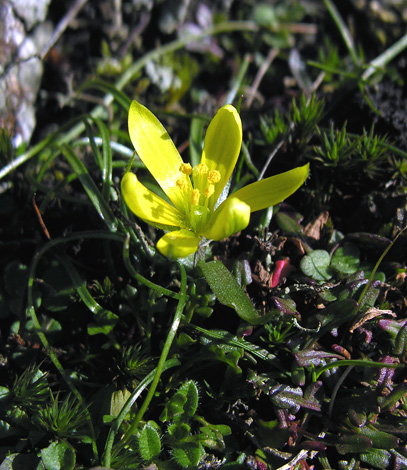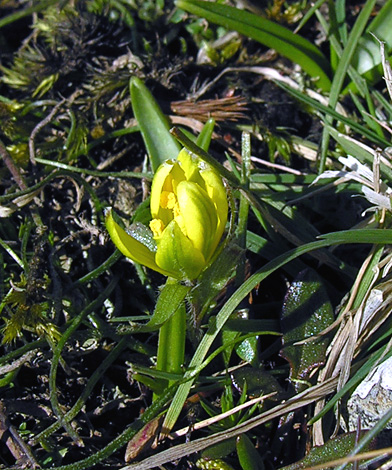Gagea bohemica Radnor Lily RR DD N


In the UK this plant lives only on the Gabbro/Dolerite igneous slabs at Stanner Rocks in Radnorshire, Central Wales. It is one of the recent discoveries having first been found by a Bryologist R. Kemp who was looking at samples of moss he had collected at Stanner in 1965. He saw a small bulb and some thin leaves amongst the moss and recorded them as probably Lloydia serotina (Snowdon Lily) another rarity of the Welsh mountains. This needed to be confirmed because Lloydia was until then only known from a few sites in Snowdonia.
In April 1974 Ray Woods went to search the area for better specimens and found some withered petals and the same leaves which Mr Kemp had discovered. These leaves though looked slightly different being hairy and were probably not therefore Lloydia he thought. He returned in mid January of the next year to find one perfect flower of what he knew was Gagea bohemica. This was later confirmed in 1978 when a Gagea expert was taken to see the site. G. bohemica is a known Mediterranean species and the colony at Stanner represents the northern most limit of its range. It grows on desiccated outcrops of thin soil high up on rocks which are quite tricky to climb and you have to look in January or February in the frost, snow and cold winds. Just to make things doubly difficult it is a winter plant which won't flower unless there is some sunshine! No wonder no-one knew it was there - who in their right minds goes botanising in January? (well....me actually). This year it is late flowering in March.
Like many rarities at the edge of their range it does not set seed but non flowering plants are actually very common at the site so it must reproduce asexually via small bulbs the size of a pinhead which grow around a parent bulb. There are estimated to be over 1,000 plants on the site but you'd have to be very familiar with the species to be able to spot non flowering plants amongst similar things like non flowering Allium vineale and Festuca sp. This year only four plants flowered.
In the photos you can make out the thin basal leaves which Mr. Kemp found in his moss sample and the wider stem leaves. This is the special plant which everyone knows about but surprisingly not the rarest at this site - the dull looking Scleranthus perennis ssp perennis grows only at Stanner Rocks and was once represented by just the seed bank the last plant having died off. There are now a twenty or so plants which flower in June.
If you would like to see this plant then it is best to contact The Countryside Council for Wales rather than try to find it yourself. Aside from any concerns about the rarity of the plant and fragility of the site, it tends to flower on the edge of dangerous drops to the quarry floor and so help is a good idea. The warden for the site (In 2007 Andrew Ferguson) will show you the plant but you will need to be able to climb steep slopes.
Stanner Rocks, Mid Wales 1st March 2006
Added on 1st March 2006, modified 12th January 2007, updated 17th Janury 2009, updated 31st March 2010, updated 16th Nov 2014




